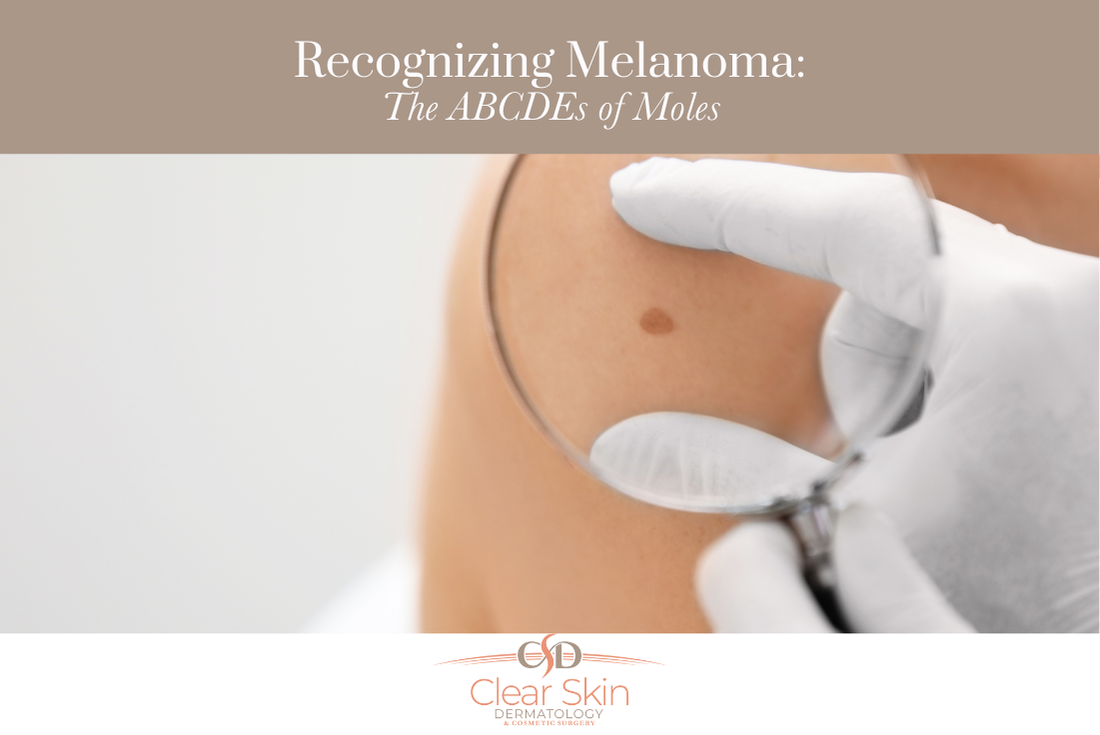 Presented by Clear Skin Dermatology & Cosmetic Surgery
Presented by Clear Skin Dermatology & Cosmetic Surgery
Skin cancer is the most common form of cancer in the United States—and melanoma, the most dangerous type, accounts for the majority of skin cancer deaths. Fortunately, early detection is possible with routine self-examinations and understanding how to spot concerning moles using the ABCDE rule. At Clear Skin Dermatology & Cosmetic Surgery, we’re passionate about skin health and committed to educating our patients on how to protect themselves.
In this blog, we’ll walk you through how to recognize the warning signs of melanoma, what makes a mole suspicious, and what to do if you find something concerning.
What Is Melanoma?
Melanoma is a form of skin cancer that develops in melanocytes—the cells that produce pigment in your skin. While it’s less common than basal or squamous cell carcinoma, it’s significantly more aggressive and can spread quickly to other parts of the body if not caught early.
The good news? When melanoma is detected early, it’s highly treatable. That’s why monthly skin checks at home and annual visits to a dermatologist are so important.
The ABCDEs of Moles: A Guide to Spotting Melanoma
When evaluating a mole or pigmented spot, use the ABCDE method to determine whether it may be suspicious:
- A – Asymmetry:
One half of the mole doesn’t match the other. Normal moles are typically symmetrical. - B – Border:
Look for edges that are irregular, blurred, notched, or jagged. A healthy mole generally has smooth, even borders. - C – Color:
Variations in color—shades of brown, tan, black, red, white, or blue—can be a warning sign. Normal moles usually have a single uniform color. - D – Diameter:
Moles larger than 6mm (about the size of a pencil eraser) should be checked, although melanoma can be smaller when first detected. - E – Evolving:
Any change in size, shape, color, elevation, or symptoms (such as itching or bleeding) should be evaluated by a dermatologist.
Other Warning Signs to Watch For
In addition to the ABCDEs, be mindful of:
- A new mole that appears after age 30
- A sore that doesn’t heal
- A mole that becomes painful, itchy, or begins to bleed
- Changes in skin texture over the mole
What Should You Do If You Spot a Suspicious Mole?
If you notice a mole that matches one or more of the ABCDE criteria—or if something just doesn’t seem right—schedule an appointment with your dermatologist as soon as possible. It’s always better to be safe and have a professional evaluation. At Clear Skin Dermatology & Cosmetic Surgery, we perform thorough skin checks and can biopsy any concerning lesions.
Comprehensive Q&A: Melanoma & Mole Concerns
Q: Are all moles cancerous?
A: No, most moles are benign (non-cancerous). However, it’s important to monitor them over time for changes and have them evaluated during annual skin checks.
Q: How often should I check my skin?
A: Perform a self-skin exam once a month and see your dermatologist annually. If you’re high-risk (e.g., family history of skin cancer, fair skin, history of sunburns), you may need more frequent visits.
Q: Does melanoma only appear in sun-exposed areas?
A: No. While melanoma often develops in areas frequently exposed to the sun, it can also appear in places like the scalp, soles of the feet, under fingernails, or even in the eyes.
Q: What causes melanoma?
A: Excessive UV exposure from the sun or tanning beds is a major risk factor. Genetics also play a role. Fair-skinned individuals with many moles or a family history of melanoma are at higher risk.
Q: How is melanoma treated?
A: Early-stage melanoma is typically removed surgically. If it has spread, treatment may involve immunotherapy, targeted therapy, radiation, or chemotherapy.
Q: Is a biopsy painful?
A: A biopsy is a minor outpatient procedure. Local anesthesia is used to numb the area, and most people experience little to no discomfort.
Why Choose Clear Skin Dermatology & Cosmetic Surgery?
At Clear Skin Dermatology & Cosmetic Surgery, our board-certified dermatologists provide expert care in skin cancer detection, mole removal, and advanced dermatological surgery. We use the latest technologies and evidence-based methods to deliver personalized skin care for every patient.
Contact Us Today
Don’t wait to get that mole checked. Schedule your skin cancer screening with Clear Skin Dermatology & Cosmetic Surgery today at one of our convenient locations:
📍 St. Charles Office
2560 Foxfield Rd Suite 100
St. Charles, IL 60174
📧 stc@cskinderm.com
📞 (630) 443-8855
📍 Oak Park Office
1050 Chicago Ave
Oak Park, IL 60302
📧 op@cskinderm.com
📞 (708) 383-6366
📍 Sycamore Office
2128 Midlands Ct, Suite 106
Sycamore, IL 60178
📧 syc@cskinderm.com
📞 (815) 895-9100
🌐 Website: https://cskinderm.com/
📅 Request an Appointment: Click here to schedule
Your skin is your body’s largest organ—protect it well.
If you’re concerned about a mole or simply due for a skin check, our team is here to help you achieve peace of mind and optimal skin health.
